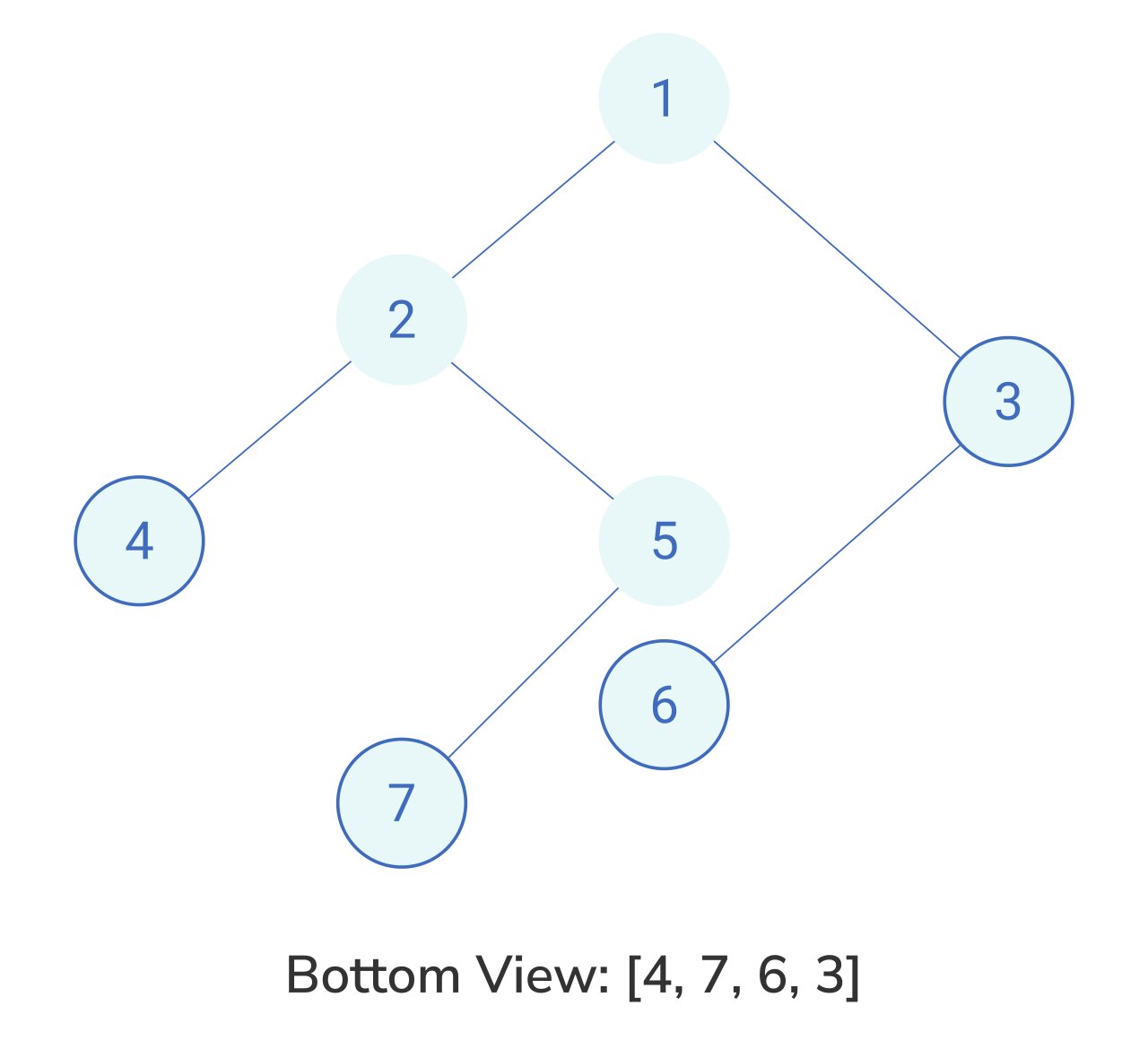Bottom View of Binary Tree
Back to home
- Problem Statement: Bottom View of Binary Tree
- Approach: Recursion
𝑻𝒂𝒃𝒍𝒆 𝒐𝒇 𝑪𝒐𝒏𝒕𝒆𝒏𝒕
 Logicmojo - Updated Aug 28, 2021
Logicmojo - Updated Aug 28, 2021
Problem Statement: Bottom View of Binary Tree
There are different ways to look at a binary tree. The bottom view of a binary tree contains the set of nodes that will be visible if you look at the binary tree from the bottom.
Note: If there are multiple bottom-most nodes for a horizontal distance from root, use the later one in level-order traversal.
Given the root node of a binary tree, return an array containing the node elements in the bottom view, from left to right.

Approach Recursive
The bottom view of a binary tree refers to the bottommost nodes present at their horizontal distance.
For the nodes of a binary tree, the horizontal distance is defined as follows.
Horizontal distance of the root = 0
Horizontal distance of a left child = horizontal distance of its parent - 1
Horizontal distance of a right child = horizontal distance of its parent + 1
Algorithm
1. Perform pre-order traversal to calculate the horizontal distance of each node.
2. For each node add the node to the result if it is the first node to have a particular horizontal distance.
3. If a node exists in the result for a particular edit distance, then only replace that node with the present node if the present node is at a level greater than that of the already added node.
C++ Implementation:
#include <iostream> #include <map> using namespace std; // Data structure to store a binary tree node struct Node { int key; Node *left, *right; Node(int key) { this->key = key; this->left = this->right = nullptr; } }; // Recursive function to perform preorder traversal on the tree and fill the map. // Here, the node has `dist` horizontal distance from the tree's root, // and the `level` represents the node's level. void printBottom(Node* node, int dist, int level, auto &map) { // base case: empty tree if (node == nullptr) { return; } // if the current level is more than or equal to the maximum level seen so far // for the same horizontal distance or horizontal distance is seen for // the first time, update the map if (level >= map[dist].second) { // update value and level for the current distance map[dist] = { node->key, level }; } // recur for the left subtree by decreasing horizontal distance and // increasing level by 1 printBottom(node->left, dist - 1, level + 1, map); // recur for the right subtree by increasing both level and // horizontal distance by 1 printBottom(node->right, dist + 1, level + 1, map); } // Function to print the bottom view of a given binary tree void printBottom(Node* root) { // create an empty map where // key —> relative horizontal distance of the node from the root node, and // value —> pair containing the node's value and its level map<int, pair<int, int>> map; // perform preorder traversal on the tree and fill the map printBottom(root, 0, 0, map); // traverse the map and print the bottom view for (auto it: map) { cout << it.second.first << " "; } } int main() { Node* root = new Node(1); root->left = new Node(2); root->right = new Node(3); root->left->right = new Node(4); root->right->left = new Node(5); root->right->right = new Node(6); root->right->left->left = new Node(7); root->right->left->right = new Node(8); printBottom(root); return 0; }
Python Implementation:
class Node: def __init__(self, val): self.val = val self.left = None self.right = None def bottom_view(root, dist_val, level = 0, dist = 0): if root: bottom_view(root.left, dist_val, level + 1, dist - 1) if dist not in dist_val or level >= dist_val[dist][1]: dist_val[dist] = [root.val, level] bottom_view(root.right, dist_val, level + 1, dist + 1) if __name__=='__main__': root = Node(1) root.left = Node(2) root.right = Node(3) root.left.right = Node(4) root.right.left = Node(5) root.right.right = Node(6) root.right.left.left = Node(7) root.right.left.right = Node(8) dist_val = {} bottom_view(root, dist_val) for dist in dist_val: print(dist_val[dist][0])
Time-Complexity: O(n)
Auxiliary Space: O(n)
With this article at Logicmojo, you must have the complete idea of solving Bottom View of Binary Tree problem.